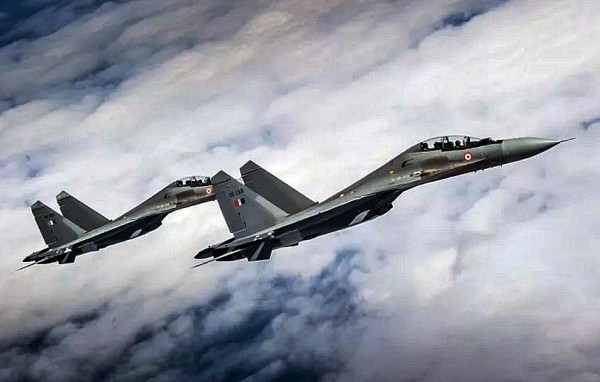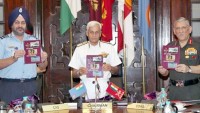Indian Air Force can ‘Win’ a Two-front War against China and Pakistan
| Arthur Dominic Villasanta | | Jun 01, 2017 07:06 PM EDT |
(Photo : IAF) Su-30MKIs of the IAF.
India can successfully fight a two-front war against China and Pakistan with the Indian Air Force (IAF) fighters it has on hand, according to analyses appearing in Indian media.
"Credible resistance" is being touted the definition of "victory" for the IAF in this two-front air war. The aim for the Indian Armed Forces in the event of this war on two fronts -- one in the high altitude battlefields along the Line of Actual Control (LAC) with China; the other in the mountains of Kashmir against Pakistan -- is to offer credible resistance for a few weeks, even for a month, before world powers intervene to prevent the conflict igniting World War III.
Like Us on Facebook
Military victory in the traditional sense is out of the question in this calculus. The only significant military victory to be gained is from attrition, that is, destroying as many enemy weapons and equipment, and killing as many enemy soldiers as possible in this short but sharp war.
The IAF is expected to play the key and lead role in the war against China, specifically against its opposite number, the People's Liberation Army Air Force (PLAAF).
The aerial battlefield for IAF and PLAAF fighters will be the high altitude regions along the LAC. The first clashes in a war against China is expected to consist of aerial battles and missile attacks on airfields along both sides of the LAC.
The LAC between India and China is 4,056 km long and traverses five Indian states: Jammu and Kashmir, Uttarakhand, Himachal Pradesh, Sikkim and Arunachal Pradesh. In China, the line traverses the high altitude Tibet Autonomous Region.
Arunachal Pradesh, which China claims it owns and Tibet will be the battlegrounds for the IAF and the PLAAF. Both Arunachal Pradesh and Tibet feature mountainous, rugged and high altitude terrain.
Air Chief Marshal Birender Singh Dhanoa, Chief of the Air Staff of the Indian Air Force, has warned his men to be prepared for a war against either China or Pakistan "at a very short notice," in what some observers see as an affirmation that war isn't a distant danger.
In a personal letter to the 12,000 officers of the IAF, the Air Marshal tacitly admits to the possibility of the IAF having to fight a two-front war simultaneously. He asks his officers to be ready.
This looming danger shines the spotlight on the need to accelerate the IAF's ongoing modernization program. The aim of this program is to replace most of its obsolete fighters bought from the Soviet Union with more sophisticated fourth generation combatants such as the Dassault Rafale, twin-engine, multirole fighter jet.
Marshal Dhanoa earlier spoke of going to war "with our present holdings," which doesn't look that good considering the planes IAF on hand. He also last year admitted the IAF doesn't have numbers in case a two-front war involving China and Pakistan broke out.
Credible resistance, however, means the IAF only has to hang on and keep shooting down PLAAF and Pakistan Air Force aircraft while losing fewer of its own.
IAF has only 35 active fighter squadrons. Of these 25 squadrons, 14 are equipped with obsolete Mikoyan MiG-21 fighters dating back to the 1970s and Mikoyan MiG-27s, which will all be retired by 2024. IAF will be reduced to just 11 squadrons by 2024.
IAF looks optimistically to the future, however. It has signed contracts to acquire 272 Sukhoi Su-30 MKI air superiority fighters, enough to form 13 new squadrons. Delivery of these potent jets will likely be completed by 2020.
Another source of optimism is the acquisition of 36 Dassault Rafale multirole fighters from France. The 36 Rafales will re-equip two existing squadrons, one of which faces Tibet.
Indian military analysts claim the IAF will have an initial advantage over the PLAAF. PLAAF fighters will take-off from high altitude airfields in Tibet, and hence will carry fewer weapons and a smaller fuel payload, limiting their range.
One great weakness of the PLAAF is its dearth of aerial refueling aircraft, of which it has less than 30 divided between the PLAAF and the People's Liberation Army Navy (PLAN).
TagsIndia, Indian Air Force, Credible resistance, china, Pakistan, Line of Actual Control, World War III, People's Liberation Army Air Force, PLAAF
©2015 Chinatopix All rights reserved. Do not reproduce without permission
EDITOR'S PICKS
-

Did the Trump administration just announce plans for a trade war with ‘hostile’ China and Russia?
-

US Senate passes Taiwan travel bill slammed by China
-

As Yan Sihong’s family grieves, here are other Chinese students who went missing abroad. Some have never been found
-

Beijing blasts Western critics who ‘smear China’ with the term sharp power
-

China Envoy Seeks to Defuse Tensions With U.S. as a Trade War Brews
-

Singapore's Deputy PM Provides Bitcoin Vote of Confidence Amid China's Blanket Bans
-

China warns investors over risks in overseas virtual currency trading
-

Chinese government most trustworthy: survey
-

Kashima Antlers On Course For Back-To-Back Titles
MOST POPULAR
LATEST NEWS
Zhou Yongkang: China's Former Security Chief Sentenced to Life in Prison

China's former Chief of the Ministry of Public Security, Zhou Yongkang, has been given a life sentence after he was found guilty of abusing his office, bribery and deliberately ... Full Article
TRENDING STORY

China Pork Prices Expected to Stabilize As The Supplies Recover

Elephone P9000 Smartphone is now on Sale on Amazon India

There's a Big Chance Cliffhangers Won't Still Be Resolved When Grey's Anatomy Season 13 Returns

Supreme Court Ruled on Samsung vs Apple Dispute for Patent Infringement

Microsoft Surface Pro 5 Rumors and Release Date: What is the Latest?












